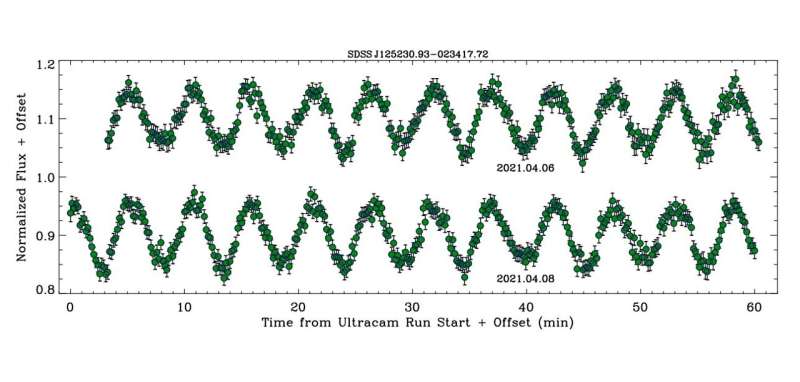July 17, 2023 report
This article has been reviewed according to Science X's editorial process and policies. Editors have highlighted the following attributes while ensuring the content's credibility:
fact-checked
preprint
trusted source
proofread
Astronomers explore the chromosphere of peculiar white dwarfs

Using the 3.6-m New Technology Telescope (NTT) at the La Silla Observatory in Chile, astronomers have observed three peculiar white dwarfs of the DAHe subtype. In their results, they found dipolar chromospheres in two of these objects. The findings were reported in a paper published July 5 on the preprint server arXiv.
White dwarfs (WDs) are stellar cores left behind after a star has exhausted its nuclear fuel. Due to their high gravity, they are known to have atmospheres of either pure hydrogen or pure helium. However, a small fraction of WDs shows traces of heavier elements.
DAHe (D: degenerate, A: Balmer lines strongest, H: magnetic line splitting, e: emission) is a relatively new and small class of magnetic white dwarfs that showcase Zeeman-split Balmer emission lines. To date, only a few dozen DAHe WDs are known. The first of them was GD 356—an isolated white dwarf discovered nearly 40 years ago.
A team of astronomers led by Jay Farihi of the University College London, U.K., decided to investigate three objects of this rare class, in order to better understand the nature of the entire population. For this purpose, they employed ULTRACAM—a frame-transfer CCD imaging camera mounted on the NTT telescope. The study was complemented by data from NASA's Transiting Exoplanet Survey Satellite (TESS).
"This study focuses on light curves and the resulting periodicities of three DAHe white dwarfs, using both ground- and space-based photometric monitoring," the researchers wrote.
The three observed DAHe WDs were: SDSS J125230.93−023417.7 (or SDSS J1252 for short), LP 705-64 and WD J143019.29−562358.3 (WD J1430). It turned out that the folded ULTRACAM light curves of SDSS J1252 and LP 705-64 exhibit alternating minima that are indicative of two distinct star spots 180 degrees out-of-phase during rotation. For WD J1430, the light curves reveal a single maximum and minimum.
The astronomers found that the amplitudes of the multi-band photometric variability reported for all the three DAHe white dwarfs are all several times larger than that in GD 356. They noted that all the known DAHe stars have light curve amplitudes that increase toward the blue in correlated ratios, which points to cool spots that produce higher contrasts at shorter wavelengths.
According to the authors of the paper, their findings suggest that some magnetic WDs create intrinsic chromospheres as they cool, and that no external source is responsible for the observed temperature inversion.
"Given the lack of additional periodic signals and the compelling evidence of DAHe white dwarf clustering in the HR diagram (Walters et al, 2021; Reding et al, 2023; Manser et al, 2023), an intrinsic mechanism is the most likely source for the spotted regions and chromospheric activity," the researchers concluded.
More information: J. Farihi et al, Discovery of Dipolar Chromospheres in Two White Dwarfs, arXiv (2023). DOI: 10.48550/arxiv.2307.02543
Journal information: arXiv
© 2023 Science X Network





















